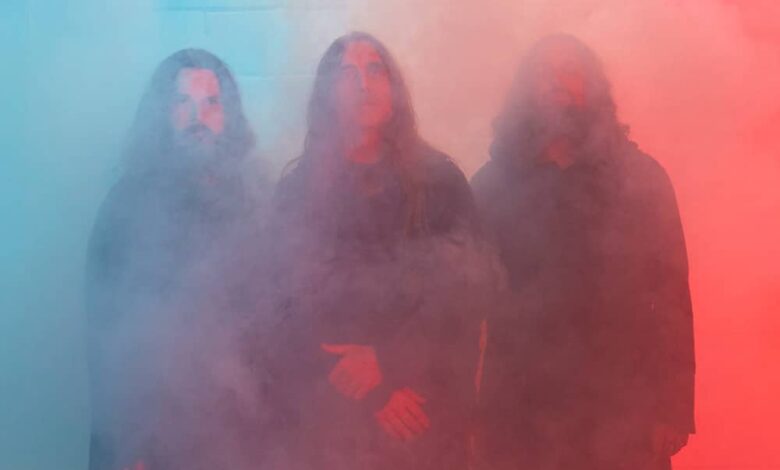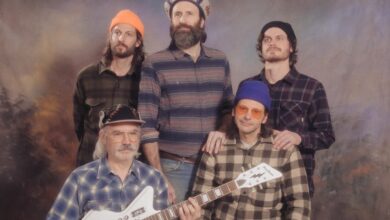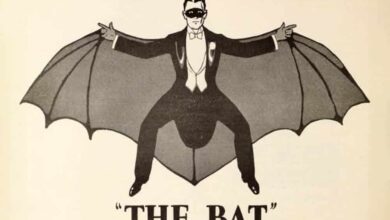Sunn O))) Brought Thundering Drone Metal to Lincoln Center

Why do you go to shows? The common assumption is that when we see bands live, we are witnessing something closer to the actual reality of the music: the musicians involved, the instruments and equipment used, and the experience of seeing the audience respond to the music in real time. In this age of self-isolation with Spotify and earbuds, listening to music can often be a solitary experience.
As a professor at the Graduate Center of the City University of New York, guitarist and composer David Grubbs has written extensively about the differences between live and recorded music in a series of books. In his first book, Records Destroy the Landscape: John Cage, the Sixties, and Recording Sound (2014), Grubbs discusses the specific tensions between recorded music and live performance.
On the one hand, vinyl records, CDs and various streaming formats have provided an indispensable means of distributing music, where the creative inspiration derived from such distribution is invaluable. “My strongest and most formative experiences with culture have had to do with things set adrift, obscure recordings randomly encountered,” Grubbs wrote at one point. “The basic appeal of records was about transcending age and geography. As a teenager in Louisville, Kentucky, in the early 1980s—and with few opportunities to see live music that I really cared about—I immersed myself in fanzines and punk and post-punk records pressed on often small labels. One time.
In contrast to this environment of remote listeners, there was a unique and unrepeatable experience of watching live music. Grubbs describes how moving to Chicago for graduate school and the ease of seeing different performances by any number of artists changed his perception of music, especially its intensity. Morton Feldman’s performance of the “radically quiet” work at DePaul University left a particularly deep impression.
As he recalls, “Feldman’s piano piece thrust me forward, straining to listen, suddenly aware of the subtle physical distance between player and listener; aware of the performance space, sonically and visually; aware of the concentration exercised by the individual listeners around me; and awake to the possibilities of music with very quiet dynamics.”


In late November, I saw Sunn O)), a Seattle-based drone metal band, perform at New York’s Lincoln Center—a band that maintains the exact opposite approach to Feldman’s. However, seeing them live brought to mind Grubbs’ statements. This occasion was the second time I had seen him Sunnah ya)))) Last year, the first was in Paris last April. Both shows featured Grubbs’ main argument about the differences between recorded and live material. They also demonstrated the episodic nature and subtle differences that can define separate shows. In short, listening to recorded music is gaining awareness; Listening to live music is gaining understanding.
Formed in 1998, Sunn O)) is managed by Greg Anderson and Stephen O’Malley, two guitarists who have been part of the metal scene since the late 1990s. They have released nine studio albums, developing a cult following for the raw quality and sheer aural volume of their music. There’s a no-frills, even Zen-like aspect to their drone metal style: just two guitars played slowly and very loudly.
Their show in April was my first time seeing them. Sunn O))) performed at L’Élysée Montmartre, a venue located in the historic bohemian district of Paris that was once known for the legendary cabaret Moulin Rouge. On this occasion, all metal members appeared in black jackets, apparently mainstream clothing, a shared and unspoken global culture, which reflected the band’s aesthetic.
To expand on this point, there is an undeniable self-aware camp quality to Sunn O))). Anderson and O’Malley appeared on stage in their distinctive Franciscan friar robes and proceeded to perform amid billowing smoke on the stage and a slow-moving light show that cast a purple atmosphere over the audience. The speakers themselves appear to be arranged as if a smaller version of Stonehenge was assembled to enhance the mood. The little red lights indicating that they were lit looked like evil eyes.
It’s both easy and difficult to describe what it’s like to listen to drone music for 80 minutes or so. Or even the call to do so. There is the novelty of listening to music so loudly that it ceases to be music. Sunn O))) is essentially testing the boundaries of what a song is: its contours, its duration, its need for rhythm, its need for change, its need for narrative. Eliminating these basic elements is arguably what defines drone music.


However, these musical qualities and their absence are accompanied by the physicality of drone metal. Sound is made up of waves, and you feel those waves shaking you, entering your body and vibrating a different energy in place. It holds the power to eliminate complacency, spiritual and otherwise.
There can be a kind of warmth, but sometimes there may be fear, or even claustrophobia. The drone metal space is not necessarily a friendly space. Maybe by definition, it’s not, given the sound of the beat. However, there is also pleasure in temporarily living in such theatrical conditions of uncertainty and fear, which is unusual for a musical performance. They call for abandoning expectations and even time itself.
This same setting was present for their performance at Lincoln Center’s David Geffen Hall on November 17, which was part of Unsound New York, a concert series curated by Matt Schulz. Given the more austere institutional context of Lincoln Center, a different side of Sunn O)) emerged. Experimental Guatemalan musician Maby Frati opened, which in retrospect seemed perfect. Although her music is very different, it shares a similar spirit of questioning what a song is about. It also made her cello sound strangely metallic.
Lincoln Center appeared both legitimate and restricted for the year O))). Although the audience was similar to the one in Montmartre, the show was seated and more formal. It had the atmosphere of a performance piece – an installation of art – and not primarily a rock show, which the Parisian look maintained. By definition, it can be difficult to know what Sunn O))) songs are playing, given their slow tempo and extreme volume. It seemed particularly difficult on this occasion, with little variation during their performance.
Does this mean that Sunn O)))’s performance at Lincoln Center was the lesser of the two? Not necessarily. The show in Paris was looser and more comfortable with an audience that knew what to expect. In New York, there have been several cases in which the audience left the hall before the end of the performance, intentionally or unintentionally, maintaining the tradition first established by Igor Stravinsky. Spring ritual In 1913.
Returning to Grubbs, Sunn O)) clearly had separate stage presences and influences on these two occasions. Their music conveyed different qualities and meanings, as the audience shaped each event. As Grubbs notes, performances are shaped not only by musicians, but also by context, audience, and similar contingencies.
In his last book, Good night, it was our pleasure (2022), Grubbs posits this ever-controversial scenario obliquely, writing: “Musicians see an opening and pounce. They emit a harsh, deafening sound, which is the most devastating attack they can perform en masse. All the howls in the room are drowned out, the sounds turning into inaudible music.
In a similar spirit, it can be difficult to determine when Sunn O))’s performance might end, given the deconstruction of the music. One sign of this was that Anderson and O’Malley stopped playing and raised their hands to the sky, while the knowledgeable audience did the same. Only a few have done so at Lincoln Center. Many have done so in Paris. There is a collective moment amidst the deafening noise and echoes, which continue after their instruments have been put out, and then the coup de grace: a sudden, resounding silence.
Source link




